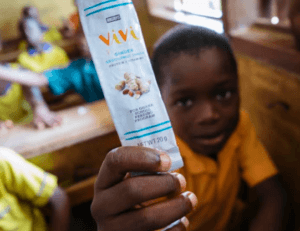How Hershey brought its ‘Miracle Food’ to Ghana
 Four years ago, a business consultant from Project Peanut Butter (PPB) walked into my Department of Commerce office in Arlington, Virginia and showed me a 60 Minutes news clip called “Plumpynut: The Miracle Food”. It described a ready-to-use therapeutic formula (RUTF) that treats a malnourished child in a number of weeks, and is a much more accessible and inexpensive substitute than going to a hospital, often too far away for many living in rural Africa.
Four years ago, a business consultant from Project Peanut Butter (PPB) walked into my Department of Commerce office in Arlington, Virginia and showed me a 60 Minutes news clip called “Plumpynut: The Miracle Food”. It described a ready-to-use therapeutic formula (RUTF) that treats a malnourished child in a number of weeks, and is a much more accessible and inexpensive substitute than going to a hospital, often too far away for many living in rural Africa.
This, I thought, could easily be as important commercially and socially as powdered milk was in the 1970’s. First introduced to African mothers through relief groups, but now powdered milk is part of everyday African family life, on the grocery shelf, next to bread, sugar and cooking oil.
“Can you help me find local partners in Ghana, so we can start up RUTF production there?” he asked, at the conclusion of the video. PPB had just forged a relationship with the Hershey Company, who would fund a factory, but still needed help finding local partners. The plan was to find palm oil producers, to provide local ingredient, and groups of buyers to distribute the finished product. Within six weeks, we had PPB on the ground in Ghana meeting with palm oil producers and non-profit organizations, who wanted to distribute RUTF for their relief programs.
After factory renovations, local business registrations, securing local utilities and setting up quality control systems, the result today is a full production factory in Kumasi, Ghana, employing 20 Ghanaians and producing 65,000 sachets daily. And, after passing a joint United Nations-Medecins Sans Frontieres quality inspection last year, they are qualified to produce RUTF for sale to U.N. agencies. The peanuts and equipment are American, palm oil and processing are Ghanaian and distribution is non-profit relief and Ghanaian ghgovernment.
“Just the beginning”, says partner, Hershey Company
End of story? “No, just the beginning”, says Hershey Company, maker of the world famous Hershey Chocolate Bar. Using the same factory, Hershey has added production of a second nutritional product called “ViVi”, a reduced version of RUTF, aimed at providing a peanut-based supplement for Ghanaian school lunch programs. After just one year of production, Hershey’s pilot program provides ViVi to 50,000 Ghanaian students EVERY DAY, bares all the expenses, and has plans to continue and grow. Their full-growth market projection is 1.3 million students, but it will be a great deal higher than that if ViVi goes the way of powdered milk!
Vivi’s trajectory into mainstream distribution will hinge on Hershey’s present and final phase of their business model: reducing costs and increasing production through buying more local Ghanaian groundnuts. Along with USAID, Hershey Company is training Ghanaian farmers to grow safe groundnuts, specifically for ViVi production, and purchasing necessary U.S. roasting equipment. The result will be a significant cost-reduction in production, mainstream distribution, increased student distribution (paid from mainstream distribution revenue), a new roasting factory and a system of collecting groundnuts from approximately 7,500 Ghanaian farmers. That’s right, while Hershey champions a new commercial market, providing nutritional benefits to thousands of students, it also creates a supply chain of 7,500 Ghanaian farms, thus insuring its future and investing in Ghana’s.
This collaborative Hershey model could be the future for U.S. companies trying to gain market share in Africa, while also investing in the future of the economy they’re accessing. Speaking on Hershey Company’s Africa strategy, their Director of Corporate Social Responsibility, Jeff King, says, “ViVi is a Hershey investment and comittment towards nourishing kids, providing Ghanian jobs and improving farmer income.”
End of story.
By William Fanjoy,
Acting Senior Commercial Officer,
US Embassy, Accra, Ghana
